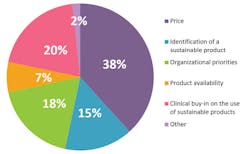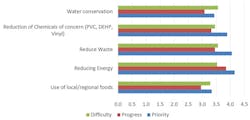Sustainability: Fusing eco- and ego-friendly efforts
Embarking on an environmentally friendly product or service initiative doesn’t have to make you see red or green — emotionally or financially. Then again, many of these projects aren’t exactly black and white either on the emotional or financial spectrum.
Sustainability can represent serious business. Some connect the word to a touchy-feely, warm-and-fuzzy political movement. Others may link it to some kind of profit maximization scheme based on the belief that environmentally friendly/green products cost more for reasons that range from more complex manufacturing or processing to no discernable reason whatsoever, save for sheer opportunity.
Either political or financial reasoning may seem accurate on the surface, but technically neither drive momentum. In its purest form, sustainability is an aim to strip out harmful additives and behavioral shortcomings and shortcuts designed to make processes and products more accessible and convenient at the expense of our long-term health.
Late this past summer Healthcare Purchasing News (HPN) partnered with Greenhealth Exchange (GX) to gauge healthcare supply chain opinions about and actions around sustainability issues and topics. Both organizations surveyed supply chain professionals, some of whom worked with dedicated internal sustainability experts, and others of whom were GX members.
The tabulated results yielded some curious findings in terms of cultural philosophies as they relate to current practices.
Initially and overall, the most glaring result was the tepid response around sustainability as a management/operational priority.
The GX-HPN survey asked respondents to rank their organization’s focus on sustainability-related activities on a scale of 1 to 10 with 1 being the least focused and 10 being very active. The largest number of survey respondents planted themselves squarely in the middle at a 5 with the next largest groups hovering in the 6 to 8 range, meaning most either seemed to be average to somewhat actively focused on sustainability-related activities, according to the survey (see Slide 1).
SLIDE 1
On a scale of 1-10, when considering other healthcare organizations, how focused is your organization on sustainability related activities?
Mary Starr, GX Vice President, Member Services, shed an optimistically positive light on the responses in context.
“It’s difficult for most people to say they aren’t looking at sustainability, particularly with the [media] featuring climate change research fairly regularly and emphasizing the critical point we all are at for making meaningful change to prevent future catastrophes,” Starr indicated, referencing the United Nations report on climate change (http://www.un.org/en/climatechange/). “Therefore, these responses probably reflect the opinion that healthcare organizations are all doing ‘something’ with sustainability. The challenge is to do enough to make a difference. If everyone is ‘average,’ then it would appear there isn’t enough work being done to address the issues around climate, chemicals and food that will impact, not just those of us working now, but also our children.”
The GX-HPN survey highlighted five specific sustainability areas. They are: Reducing energy consumption, reducing waste production, reducing water consumption, reducing chemicals of concern usage and increasing use of local/regional food.
Some weren’t surprised by the results.
Mary Crawford, Senior Director, Procurement and Supply Chain, Small Business Liaison Officer and Certified Supplier Diversity Professional at Duke University Health System is but one example. In fact, she attributes it to customer diversity.
“As a member of a university and health system community, I feel this is an accurate depiction of the current state of initiatives around sustainability in healthcare,” she acknowledged. “It is certainly more of an actively focused initiative in the university setting, primarily as it is greatly driven by students who spend several years invested at the school. One might argue that in a hospital system, the demand from a similar population is not present as the guests are primarily transient and too short-term in nature to push the agenda.
“From a staff perspective and having coordinated the implementation of some sustainability initiatives into the health system, I have found that staff member participation is generally fleeting at best, primarily due to the nature of their positions in many cases,” Crawford continued. “They are there to serve patients, provide care and save lives. Healthcare is a fast-paced industry and oftentimes initiatives such as this are on the back burner.”
While Duke employs several persons with roles that help make Duke more sustainable, according to Crawford, she oversees Duke’s green purchasing and supplier diversity programs that impact sustainability initiatives.
“There is a different set of rules in this space as well which greatly impacts these initiatives,” she noted. “Patient safety comes first, which limits implementation and accessibility to simple processes such as composting, recycling, Styrofoam elimination and green chemical product selection. Coupled with the premium to purchase many more sustainable items — although overall ROI might be increased — this is generally enough to intimidate those with some interest into shying away from making sustainability a priority.”
Pulling sustainability to the forefront of competing priorities requires conscious effort and not doing it alone, according to Jeffrey Stoner, Purchased Services Administrator, Dignity Health, Santa Cruz, CA.
”Balancing clinical, operational, contractual and business objectives is a challenging task on its own,” Stoner told HPN. “While sustainability is part of any contracting conversation, it is infrequently a driving principle and can be easily overshadowed. Sustainable purchasing activities are more likely to be adopted if they can positively impact other KPIs as well.”
Stoner encourages reaching out to vendors. “Vendors play a critical role,” he added. “Those willing to partner with Dignity Health and our end-users to lend their expertise and help guide us to creative solutions that meet all of our mutual goals are positioned for success. We have seen success in starting small by making small improvements to show proof of concept and create an avenue for further change.” (For example, read more about Dignity’s programs here: https://www.hpnonline.com/going-green-without-seeing-red/.)
Carrying a torch for sustainability initiatives can be exhausting and frustrating, admits Steven Bergstrom, Director, Office of Sustainability, Intermountain Healthcare Supply Chain Center, Midvale, UT.
“I think that you can reach a point of burnout when it seems everything you are trying to do is a constant battle and there doesn’t seem to be executive support,” he said. “Setting reasonable and realistic goals and expectations will help as well as engaging executive sponsors from the start. It can’t be a one-man-show either so make sure to enlist as much help as possible.
“Getting traction with caregivers is often hard because they are so busy and are not making the connection between sustainability and health issues,” Bergstrom added.
Sister Mary Ellen Leciejewski, OP, Vice President, Corporate Responsibility, Dignity Health, cautions against “short-term vision, lack of expertise in sustainability,” as well as allowing “very full plates” to prevent it from being an incentivized strategic issue, “not realizing that ‘business as usual’ is impacting our health.”
Rochester, MN-based Mayo Clinic has established specific goals to become more eco-friendly, according to Bruce Mairose, Vice Chair, Supply Chain Management, Category Management.
“We have long had recycling programs for plastics, paper and other products used in patient care,” Mairose noted. “Interest in this space is growing as part of a generational shift. Rather than having a specific step or checkbox to consider eco-friendly options it has to become, and needs to be, a part of the culture and way of doing business, not just another data point to consider.”
Office supply retailer Staples maintains a positive outlook on sustainability growth in healthcare over time.
“We see higher interest from healthcare, higher education, government, and larger corporations compared to other verticals,” said Jake Swenson, Director of Sustainability, Staples. “Yet we also see that even within customers actively pursuing, there are definitely still barriers, including difficulty in deciphering how to implement sustainability, confusion around navigating all of the ecolabels and claims, and getting organizational alignment to implement solutions.”
Igniting the spark
Experts largely agree that no single solution should or would increase interest in sustainability as a topic or an activity worth implementing.
In fact, the GX-HPN survey found that senior leadership support and education offers the greatest value in driving sustainability influence (see Slide 2). Support from senior leadership attracted nearly 47 percent of responses, followed by education at more than 23 percent, the survey showed.
SLIDE 2
What would drive you to put more focus on sustainability initiatives in your hospital? (choose the one that would have the greatest influence)
To get more interest and engagement, sustainability needs to be easier for everyone to practice in their everyday lives, and there needs to be more alignment,” argued Staples’ Swenson. “In my experience, when sustainability objectives are built into how an organization wants to operate and how employees are evaluated and when specific criteria or standards are agreed upon to help drive sustainable outcomes (for example in procurement of products or services), organizations find creative ways to implement solutions that financially work for the organization and achieve those objectives. As far as increasing participation, we have used utility incentives, rebates, training, contests and demand response programs to help reduce energy consumption and expenses and to help advance recycling in our facilities. We see more regulations and fines to be more an influence in recycling and waste consumption. As far as sustainable purchasing, organizational guidelines, criteria, goals and tracking and reporting can be valuable.”
Mayo Clinic’s Mairose emphasizes the softer approach, too.
“Education is the only way to move the ball forward on the buyer side of the supply chain,” he said. “Regulations and penalties will only serve to increase expense in a sector of the industry that is still nascent at best with undefined expectations and widely varying definitions of sustainable products.”
Don’t underestimate the sales pitch, urged Intermountain’s Bergstrom, with the hammer being something of a last resort.
“I believe that part of the solution is to prepare a compelling case for the initiative, make a solid connection to the health benefits of the initiative, and make sustainability a part of performance reviews,” he said. “Carbon fees and regulation certainly will get the attention of our businesses and may be the only way to elevate the needed action.”
Duke’s Crawford favors incentives over penalties as the preferred motivator.
“Regulations, fees and fines are not necessarily the driving force to increase interest in this space,” she asserted. “Without enforcement, which in this environment would be unlikely due to more pressing demands, they don’t work. Incentives would be a positive, not negative reward, which may draw more interest to perform at a higher level of sustainable involvement.”
Greenhealth Exchange’s Starr concurs.
“Measured goals would be one of the best ways to see progress improve,” Starr indicated. “Peter Drucker’s ‘If you can’t measure it, you can’t improve it’ is quoted over and over because it is proven correct so often. Goals not only communicate organizational priorities, but also focus efforts. Whether it’s water conservation, elimination of chemicals of concern, or increasing the use of local/regional foods, an established goal has everyone focused on common categories/work. When those goals are set and communicated with/by senior leadership, they carry the most weight and get the most attention. Therefore, success is more likely with leadership involvement and endorsement.”
Dignity Health’s Leciejewski, however, articulates two examples about the effectiveness of regulations in practice in California.
“When polystyrene foam was banned from our county, it’s usage in our hospital declined quickly; polystyrene is nearly impossible to break down and hazardous to the environment and marine life,” she said. “California has defined two groups of food generators that will [have] to comply with the requirements of SB1353 (50 percent reduction in Landfill Organic Waste by 2020; 75 percent reduction in Landfill Organic Waste by 2025; 20 percent edible Food recovery goal by 2025) by January 1,2024. There will be two driving forces: To decrease production and to recycle leftover food. This regulation will definitely help in our program development.”
What douses the flame?
The biggest obstacle in a healthcare organization’s ability to purchase and implement the use of more sustainable products reveals some familiar bad news but in a good way, the GX-HPN survey showed.
Yes, respondents pointed to price as the No. 1 obstacle but at only 38 percent that excuse represented a plurality and not majority as in past years, which indicates progress, according to GX’s Starr (see Slide 3).
SLIDE 3
What do you believe is the biggest obstacle in your organization’s ability to purchase and implement the use of more sustainable products?
More noteworthy is the No. 2 hurdle at 20 percent: Clinical buy-in on the use of sustainable products. Because value analysis professionals tend to spearhead sustainability efforts and clinicians tend to dominate the value analysis segment this figure raises eyebrows.
Starr attributes the curious statistic to awareness and knowledge.
“In many cases, it may be that clinicians aren’t knowledgeable about what sustainability features or attributes they should be watching,” she said. “Sustainability is often viewed as doing things that improve the impact on the environment and not as something that impacts patient care. Chemicals of concern should be of particular concern for clinicians because of the health problems they are suspected of causing.”
Close on the heels of clinical buy-in is organizational priorities at 18 percent, according to the survey.
Dignity Health’s Stoner taps into that vein. “Wide ranging executive support can be difficult among the many competing priorities our leaders face,” he said. “When system-wide initiatives are developed, the burden of decision-making is reduced, and we can overcome some of the hurdles that might otherwise be too high for an individual facility to surpass on their own. Reliable, readily available data has become increasingly important to track and communicate, not only to understand if we are able to meet stated objectives, but to encourage ongoing dialogue, promotion of success stories and continued advancement efforts.”
Duke’s Crawford identifies a confluence of issues from the individual to the collective and corporate.
“It is a challenge to establish a baseline and project scope in these particular areas, as well as long-term project oversight,” she indicated. “There is often a lack of system-wide communications around these efforts, meaning they are often occurring but there is no larger group to present to who would track and disseminate this data. There is also a vendor component, and behavioral changes need to include vendor input as they are stakeholders as well.”
Financials take precedence, according to Intermountain’s Bergstrom, followed by areas targeted.
“Funding is always an issue as you compete for limited or reduced dollars,” he said. “The formulas and modeling that we continue to use needs to be re-evaluated to include different factors such as risk, cost of environmental impact on health issues, longer-term ROI, etc.
“Tackling issues like water quality and reduction are difficult because the cost of water is so inexpensive,” Bergstrom continued. “It is also difficult because people have to see the problem, such as algae bloom, or have a direct cause and effect, such as lead in the water/brain development issues or poor air quality/cardio-respiratory episodes.”
Dignity Health’s Leciejewski points to water as a key hurdle: “The challenge is bringing potable water demand down,” she said. “Water is very inexpensive, causing few projects to make economic sense, with most paybacks exceeding 15 to 18 years.
The GX-HPN survey found that each of the five sustainability areas had its own degree of priority, progress and difficulty. Reducing energy topped the priority and progress lists, but reducing waste and conserving water topped the difficulty list (see Slide 4).
SLIDE 4
Priority vs. Progress vs. Difficulty
Mayo’s Mairose explains that each of the five sustainability areas pose its own hurdles.
“For chemicals of concern, affordable products that provide equal or improved outcomes and performance is a major challenge,” he said. “There are chemicals of concern that have a significant impact on how products feel and perform in the clinical area. Transitioning can be a challenge. Water Consumption — one of the most critical products for patient care is water in all forms and in all phases of care delivery. An organization can focus on water reduction in areas that are not directly impacted by patient care, e.g., eco-friendly landscaping, etc. However, making a meaningful impact can be challenging. For a large organization to truly leverage locally sourced foods, it can be very disruptive to the supply chain if not performed within the framework of local sourcing programs offered by food service distributors. Waste reduction is a challenge in an industry where more products are rapidly moving from reusable to disposable. It can be hard to discern when the transition to disposable is truly needed for infection prevention and control.”
Staples’ Swenson concurs that challenges can vary depending on the area — both geographic and product.
“Growing energy demand and the reliability of the grid are challenges in energy as well as high energy rates in some areas of the country,” he noted. “Finding new technologies to assist in reducing energy load and cost that are reliable also takes effort. Internal initiatives to help reduce waste to the landfill, along with the awareness of water consumption and how to educate to reduce water waste can all be challenges. For chemicals of concern, the first challenge is getting transparency into what is in all of the stuff you are bringing into your buildings from the manufacturers and then understanding if there are safer alternatives. We don’t source a ton of food, so hasn’t been a top priority for our organization, but I can see availability of different products and pricing of local/regional and finding the right supplier partners to be challenges.”
Editor’s Note: For more details and information about the survey, contact Greenhealth Exchange by visiting their web site at www.greenhealthexchange.com).
The story continues:
About the Author
Rick Dana Barlow
Senior Editor
Rick Dana Barlow is Senior Editor for Healthcare Purchasing News, an Endeavor Business Media publication. He can be reached at [email protected].












